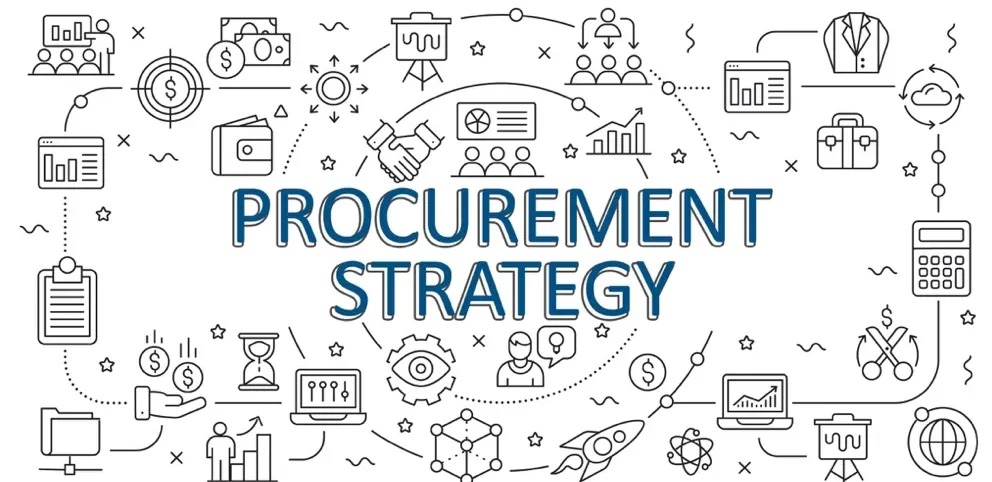Indirect procurement takes place in businesses of all sizes, and this vital process affects their financial performance and purchasing strategies. However, indirect purchases are paying more attention to the increasing levels of professional services, for which they use digital solutions to manage their operational expenditures and overall incomes. Companies that understand the difference in details between direct and indirect procurement are essential in such a way that it may increase profitability but not strain the quality of the acquisitions made. This means that procurement strategies have to be guided in a manner through which the businesses will develop and fine-tune their approaches with reference to the growth objectives and operational needs.
Table of Contents
- What is Indirect Sourcing?
- Differences between direct and indirect procurement
- Focus on Building Supplier Relationships in Direct Procurement
- Strategic Spending vs. Ad-Hoc Purchases
- Effective Inventory Strategies
- Optimizing Procurement: Strategies and Insights
- Navigating the Complexities of Indirect Procurement
- Common Challenges and Missteps in Indirect Procurement
What is Indirect Sourcing?

Indirect procurement, otherwise termed as indirect spending, refers to the purchase of goods and services where such are not directly required in the day-to-day running of a corporation but support its functioning. This class includes things like office supplies, decor, and stationery. They help in providing necessary support but are not part of the end product or service offered to clients. They are further subcategorized into two more groups: direct consumables and indirect consumables. Examples of indirect supplies include company subscriptions to software as a service (SAAS), employee development tools, office decoration, and essential hardware like laptops and PCs.
Basically, all these are types of consumables that are important for running operations but have no capacity for production. This is of more significant importance in the digital type of service than the sale of manufactured products.
Differences between direct and indirect procurement
The fundamental distinction between direct and indirect procurement lies in their respective purposes. Direct procurement is concerned with acquiring essential materials that are integral to the creation of products or services delivered to customers. In contrast, indirect procurement involves obtaining goods that, while not central to the end product, are vital for the business’s operations. These differing roles necessitate distinct strategies for each type of procurement, requiring tailored approaches to optimize each function effectively.
| Direct | Indirect |
| Highly essential for the company’s main activities | Not directly essential for the company’s primary operations |
| Direct procurement items are components of the product sold to consumers | Items obtained via indirect procurement do not contribute directly to the product sold |
| Purchased in substantial quantities but infrequently | Acquired in smaller quantities but with greater frequency |
| Considered a top priority and receives a considerable share of the company’s spending | Considered a lower priority and often receives less attention in budgeting |
| Examples: Steel for automobile manufacturing, ingredients for a restaurant, and electronics for computer assembly | Examples: Cleaning supplies, software licenses, and employee training programs. |
Focus on Building Supplier Relationships in Direct Procurement
This is procurement that deals with the primary material for your business offering, and if not obtained, the business operation cannot proceed. Suppliers will, therefore, be required to foster solid relationships over the long term to achieve consistency in the relationship within the supply chain. This will definitely involve strategic vendor management, contract negotiations, and an agreement on minimum order quantity conditions that would be key in the cultivation of a responsive partnership.

Indirect procurement is essentially the process of acquiring goods or services to support your business operation, but it is central to your core offering. In simple words, this kind of item doesn’t need the same amount of relationship management as it requires indirect procurement. In the case of indirect procurement, the companies operate primarily with a plurality of suppliers whom they substitute without any problem, so there is no such great urgency to cultivate deep, long-term relationships. They are mainly focused on convenience and operational support rather than some severe supply continuity.
While direct procurement needs vendor relationships and strategic sourcing approaches to guarantee that business core operations are not jeopardized, indirect procurement is more flexible and enables businesses to interchange their suppliers without grave implications for them. The differentiation is also essential, as it brings out the different forms of dependence and strategic focus with respect to managing the relationships between direct and indirect suppliers.
Strategic Spending vs. Ad-Hoc Purchases
Direct procurement is focused on securing the essential materials necessary for your business’s daily operations, requiring careful planning and strategic budgeting to maintain supply chain continuity. These vital resources must be procured methodically, with foresight, to prevent any interruptions in your business activities.
Conversely, indirect procurement is characterized by its less predictable nature. Estimating the exact demand for indirect supplies is challenging, leading to minimal planning or budgeting in this area. These supplies are typically acquired on an as-needed basis, reflecting a more spontaneous approach to procurement compared to the structured and proactive strategy associated with direct procurement.
Effective Inventory Strategies
Effective inventory management involves the acquisition, storage, and planning of stock, typically focusing on direct supplies due to the significant impact they have on the supply chain. The strategic management of these materials is crucial due to the associated risks and rewards.
In contrast, indirect supplies rarely have a long-term inventory management strategy because their procurement is generally unplanned. This lack of planning can introduce challenges in maintaining inventory levels, ensuring product quality, and ensuring supplier adherence to an organization’s specifications and quality standards.
Optimizing Procurement: Strategies and Insights

Elevating this crucial business function transcends mere cost reduction—it’s about averting unnecessary expenditures, enhancing transparency and oversight, optimizing facilities management, and refining supplier relations.
What distinguishes a proficient indirect procurement strategy from an ineffective one?
Enhance Spend Transparency
Many purchasing processes fall short of efficiency due to their disjointed nature and the lack of cohesive approval within the organization. By enhancing the visibility of financial activities, you pave the way for significant improvements in procurement practices.
Streamline Your Data
Indirect spending is often plagued by inconsistency due to its varied nature and origination from multiple departments. Implementing robust data management practices can address this challenge, organize the chaos, standardize data analytics, and foster transparency.
Implement Strategic Sourcing Techniques
Begin by examining your contracts to identify cost-saving opportunities through strategic sourcing. Next, work closely with your suppliers to actualize these savings. Ensure your actions are in sync with your company’s overarching objectives and establish your benchmarks to evaluate your performance.
Optimize Your Supplier Network
Linked to your sourcing tactics, a significant portion of your role involves negotiating fresh contracts, fostering constructive interactions with suppliers, and tracking vendor performance. Expenditures should be made ethically and sustainably.
Train Your Team on Indirect Procurement
Given that employees are the ones executing these purchases, the procurement team must prioritize educating all company members on the newly established policies. What initiatives are you implementing to enhance procurement efficiency, and in what ways can each employee contribute? There are software tools tailored for managing indirect spending that provide guidance and resources for employee self-training on these new procedures, a process termed “change management.”
Ensure your new policies are straightforward and accessible. The more complex the compliance process, the more delayed the outcomes will be. By simplifying the adherence to new guidelines, you facilitate quicker and more effective results, aligning with the overall efficiency goals of your procurement strategy.
Collaborate with the Finance Team
Procurement and finance are closely interconnected in their functions. Analyzing spending performance using financial data provides insights that inform future procurement strategies. Additionally, when procurement and finance departments are aligned, it simplifies processes for Accounts Payable, enhancing overall operational efficiency.
Engage with a Group Purchasing Organization (GPO)
In the health sector, Group Purchasing Organizations (GPOs) are generally applicable. They refer to an organizational form where groups of entities combine their needs into the negotiation process, leveraging the resulting collective buying strength to acquire volume discounts from distributors. It minimizes the risks for suppliers and helps to identify potential vendors quickly, at the same time making the whole process less time-consuming and strenuous.
Leverage Digital Solutions
Software and automation have significantly boosted business productivity, a trend that extends to cloud eProcurement solutions. These automated systems can actualize your new strategies by minimizing human errors, enhancing transparency, and offering precise analytics on spending data.
The data analysis dashboards visualize your cost savings and strategic partnerships with the management while giving you a better granular overview of your expenditure—anyone-friendly and accessible to all, whether inside or outside of the procurement team.

- Indirect procurement requires going through a unique approach that is different from strategies applied in procurement involving materials used in the manufacture. The set team is exposed to a number of challenges, such as:
- The vastness of operations. Handling extensive contracts with numerous suppliers and managing hundreds of spending categories can be overwhelming.
- Limited transparency. Approval processes can be hindered when approvers are not engaged from the start or are not kept informed, leading to potential delays and information gaps.
- Initiating spend control. With a variety of individuals requesting and approving purchases, gaining a comprehensive understanding of where and why spending is necessary can be challenging. Streamlining these processes is crucial for enhancing visibility and control.
With proper planning, any organization can harness the advantages of indirect procurement, establish more robust agreements with suppliers, and foster a more efficient purchasing environment. Now, let’s explore the strategies and best practices to achieve this.
Common Challenges and Missteps in Indirect Procurement

Effective optimization of indirect procurement is unattainable without a skilled team and a modern software-driven approach. Yet, even with these elements in place, it’s crucial to sidestep common pitfalls during supplier negotiations.
- Avoid haste in decision-making. Vendors, sensing a lack of alternatives on your part, may increase their demands. Secure all necessary concessions from your preferred supplier before finalizing your choice.
- Conceal your budget. Revealing your total budget can diminish your negotiating power, as suppliers are adept at maximizing their end of the deal.
- Leverage timing to your advantage. Vendors can exploit deadlines to their benefit, such as your need to agree by quarter-end. Keep such timelines confidential during negotiations to maintain your bargaining position.
To minimize costs, strike favorable deals with suppliers, and get the maximum competitive advantage out of indirect procurement, consider the implementation of an eProcurement system. This is one central area in which you can cut costs.
Frequently Asked Questions
How are direct spending and indirect spending different?
Direct procurement is the set of procedures through which a company acquires the physical goods and raw materials that it intends to put to use in its primary production. However, indirect procurement covers the provider selection of services and things needed for day-to-day operations, including office supplies, SaaS subscriptions, and costs in the process of employee management.
As a result, why is indirect procurement important?
Good manufacturing processes ensure a low cost of goods and services, the quality of which can be guaranteed by stable and devoted providers. These procurement practices can support the whole business performance.
SAP stands for indirect procurement; what is it?
The SAP exercises indirect procurement via the acquisition of indirect materials and management of subcontracting activities. This encompasses the use of standard functions, including MRP (“Material Requirements Planning”), ordering purchase requisitions, organizing stock transport orders, transport planning, and monitoring internal deliveries.
Should we mark marketing as an indirect procurement activity?
Marketing expenditure is indirect spending, as it does not have a direct impact on the manufacturing or core processes of a business. Each industry has different marketing expense budgets. Nonetheless, some essential marketing services are typically recognized as the most important.
What are the differences between direct and indirect spending on a purchase?
Both direct and indirect expenditures are undeniably critical in defining purchasing. Booking of direct spending is when the firm mainly spends on materials that are directly linked to the items and services sold to customers. Indirect spending does not include purchasing office goods and utilities that are eventually used to maintain and operate a business in a way that these do not become a part of the goods and services offered to the final customers.
